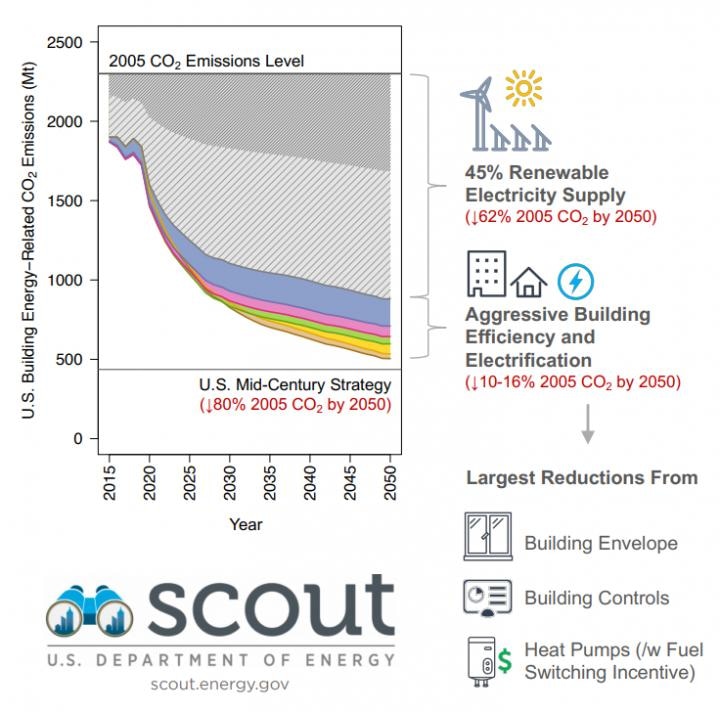Aug 16 2019
In the United States, use of energy in buildings — from cooling and heating a house to keeping the lights on at workplace—leads to more than one-third of all carbon dioxide (CO2) emissions. Therefore, reducing building CO2 emissions up to 80% by 2050 will significantly help to fight against climate change.
 Increased generation of electricity from renewable sources, efficient energy use and management in buildings, and electrification of fuel-fired building technologies outline a roadmap to U.S. buildings emissions reduction by 2050. (Image credit: Langevin et al./Joule)
Increased generation of electricity from renewable sources, efficient energy use and management in buildings, and electrification of fuel-fired building technologies outline a roadmap to U.S. buildings emissions reduction by 2050. (Image credit: Langevin et al./Joule)
Scientists from two U.S. national laboratories have developed a new model that indicates this goal could be achieved using new operational approaches, the installation of highly energy-efficient building technologies, and electrification of building systems that directly use fossil fuels, together with the increase in the share of electricity produced from renewable energy sources. The study has been published in Joule on August 15th, 2019.
Buildings are a substantial lever to pull in trying to reduce total national CO2 emissions since they are responsible for 36% of all energy-related emissions in the U.S. Because the buildings sector uses energy in a multitude of ways and is responsible for such a large share of electricity demand, buildings can help accelerate the cost-effective integration of clean electricity sources on top of contributing direct emissions reductions through reduced energy use.
Jared Langevin, Study Lead Author and Research Scientist, Lawrence Berkeley National Laboratory
For several decades, the scientists considered using three kinds of efficiency measures to determine the extent of feasible CO2 emission decreases from the U.S. building sector. These were sensing and control strategies that enhance the efficiency of building operations; technologies with high energy performance compared to typical alternatives, like air sealing of walls and dynamic windows; and conversion of fuel-fired heating and water heating equipment to similar systems that could work using electricity.
Moreover, the scientists considered how the simultaneous addition of renewable energy sources to the electric grid can change emission reduction estimates from each building efficiency measure and the entire building sector.
While building CO2 emissions are quite sensitive to the greenhouse gas intensity of the electricity supply, measures that improve the efficiency of energy demand from buildings need to be part of the solution.
Jared Langevin, Study Lead Author and Research Scientist, Lawrence Berkeley National Laboratory
Langevin added, “Getting close to the 80% emissions reduction target requires concurrent reductions in building energy demand, electrification of this demand, and substantial penetration of renewable sources of electricity—nearly half of annual electricity generation by 2050. Moreover, buildings can support the cost-effective integration of variable renewable sources by offering flexibility in their operational patterns in response to electric grid needs.”
The researchers analyzed the outcomes for particular efficiency measures and discovered two specifically potential ways for lowering emissions. The first one is to perform energy-saving retrofits and upgrades to windows, walls, roofs, and insulation—what is called the building “envelope”—that can also increase living and working comfort for building residents.
The second one concentrates on smart software that can optimize where, when, and to what extent energy-intensive building cooling, lighting, heating, and ventilation services should be supplied.
The scientists emphasized that these strategies and emissions can be made advantageous depending on the follow-up measures by manufacturers, vendors, policymakers, consumers, and building service professionals.
“Regulations and incentives that support the sale of more efficient, less carbon-intensive technology options, early-stage research and development that drives breakthroughs in technology performance, aggressive marketing of those technologies once developed, training for local contractors charged with technology installation, and consumer willingness to consider purchasing newer options on the market are all needed to achieve the 80% emissions reduction goal by 2050,” stated Langevin.
To boost the repeatability and transparency of their analysis, the team has released its efficiency estimates and findings data, all produced using a model called Scout, which could be updated every year to show the main changes in the electricity supply environments and building energy use.
We look forward to periodically revisiting this analysis to reassess where emissions from the buildings sector stand relative to the 2050 target, under both business-as-usual and more optimistic scenarios of efficient technology adoption and renewable electricity supply.
Jared Langevin, Study Lead Author and Research Scientist, Lawrence Berkeley National Laboratory
This study was financially supported by the U.S. Department of Energy’s Building Technologies Office.